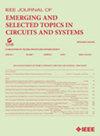Reinforcement Learning (RL)-Based Holistic Routing and Wavelength Assignment in Optical Network-on-Chip (ONoC): Distributed or Centralized?
IF 3.8
2区 工程技术
Q2 ENGINEERING, ELECTRICAL & ELECTRONIC
IEEE Journal on Emerging and Selected Topics in Circuits and Systems
Pub Date : 2024-07-30
DOI:10.1109/JETCAS.2024.3435721
引用次数: 0
Abstract
With the development of silicon photonic interconnects, Optical Network-on-Chip (ONoC) becomes promising for multi-core/many-core communication. In ONoCs, both routing and wavelength assignment have an impact on the communication reliability and performance. However, the interactive impact of the routing and wavelength assignment is rarely considered. To fill this gap, this work proposes an adaptive and holistic method of routing and wavelength assignment (RWA) based on Reinforcement Learning (RL) for ONoCs. Routing and wavelength assignment is treated as a whole problem and participate in the same Markov decision process. Two corresponding implementation methods, i.e., distributed and centralized, are proposed, by using intelligent learning algorithms to process and learn the dynamic on-chip network information in multi-dimensional. Instead of considering routing and wavelength assignment separately in steps, the evaluation results show that the proposed holistic method improves by 2.58 dB, 9.21%, and 53.26% in the aspects of OSNR, waiting delay, and wavelength utilization respectively, in cost of 16.15% loss of load balancing. As for the distributed method and centralized method, the distributed method improves by 0.37 dB and 0.69% in the aspects of OSNR and waiting delay, but the centralized method improves by 13.84% and 4.46% in the aspects of load balancing and wavelength utilization.基于强化学习(RL)的片上光网络(ONoC)整体路由和波长分配:分布式还是集中式?
随着硅光子互连技术的发展,片上光网络(ONoC)在多核/多核通信方面大有可为。在 ONoC 中,路由选择和波长分配都会对通信可靠性和性能产生影响。然而,路由和波长分配的交互影响却很少被考虑。为填补这一空白,本研究提出了一种基于强化学习(RL)的自适应整体路由和波长分配(RWA)方法。路由和波长分配被视为一个整体问题,参与同一个马尔可夫决策过程。通过使用智能学习算法多维度处理和学习片上动态网络信息,提出了分布式和集中式两种相应的实现方法。评估结果表明,所提出的整体方法在 OSNR、等待延迟和波长利用率方面分别提高了 2.58 dB、9.21% 和 53.26%,而代价是负载平衡损失了 16.15%。至于分布式方法和集中式方法,分布式方法在 OSNR 和等待延迟方面分别提高了 0.37 dB 和 0.69%,但集中式方法在负载平衡和波长利用率方面分别提高了 13.84% 和 4.46%。
本文章由计算机程序翻译,如有差异,请以英文原文为准。
求助全文
约1分钟内获得全文
求助全文
来源期刊

IEEE Journal on Emerging and Selected Topics in Circuits and Systems
ENGINEERING, ELECTRICAL & ELECTRONIC-
CiteScore
8.50
自引率
2.20%
发文量
86
期刊介绍:
The IEEE Journal on Emerging and Selected Topics in Circuits and Systems is published quarterly and solicits, with particular emphasis on emerging areas, special issues on topics that cover the entire scope of the IEEE Circuits and Systems (CAS) Society, namely the theory, analysis, design, tools, and implementation of circuits and systems, spanning their theoretical foundations, applications, and architectures for signal and information processing.
 求助内容:
求助内容: 应助结果提醒方式:
应助结果提醒方式:


